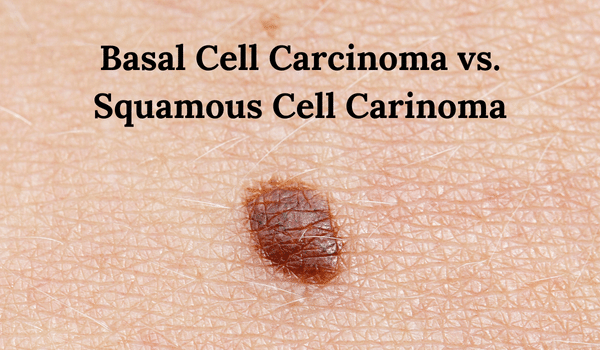Skin cancer, also known as carcinoma, is one of the most common types of cancer. Understanding basal cell carcinoma vs squamous cell carcinoma can help you understand the importance of routinely performing an at-home skin cancer screening. Identifying potentially cancerous cells early not only allows your dermatologist to provide the best treatment possible, but also increases the chances of a positive outcome.
What is the Difference Between Basal Cell Carcinoma vs Squamous Cell Carcinoma?
When comparing basal cell carcinoma vs squamous cell carcinoma, there are different signs and symptoms to be aware of. Understanding these differences can help you identify early signs of skin cancer and understand the treatment options available to you.
Basal Cell Carcinoma
Basal cell carcinoma is the most common type of skin cancer. It is not contagious but can appear anywhere on the body. Basal cell carcinoma grows slowly and can often be mistaken for acne or a scar. Dermatologists recommend watching for early signs of basal cell carcinoma. These early signs include:
- A reddish or pink growth that dips in the center that is often mistaken for an acne scar.
- A scaly patch or growth near the ear that resembles a sore or minor skin injury.
- A sore that has a difficult healing process. This sore may ooze, bleed, or reopen after healing.
- A slightly raised, scaly patch of skin, which can be pink or red. Many people mistake this as dry skin.
- A growth that is red, brown, or the color of your skin, often mistaken for warts or moles.
- A small area of skin that feels slightly scaly and can look as if it is a freckle or age spot.
- An area of skin that is white, yellow, or skin-colored. This growth may look waxy and feel tight around the edges. This is often confused for a scar.
Squamous Cell Carcinoma
Squamous cell carcinoma is another common form of skin cancer and often develops from a pre-cancerous skin growth. Squamous cell carcinoma can occur anywhere there are squamous cells in the body (i.e. skin, lungs, etc.). When this type of cancer occurs in the skin, it is not usually life-threatening.
Although not usually life-threatening, squamous cell carcinoma can grow deep into the skin. The deeper it grows, the more likely there is to be damage to your nerves, blood vessels, or anything else in its path. As this cancer grows, it can form into a tumor.
Since squamous cell carcinoma can occur in many places throughout the body, there are different warning signs for the different areas of the body. When occurring in the skin, early signs of squamous cell carcinoma include scaly patches of skin, open sores with a raised border, and sores developing from an old scar. Additional signs include browns spots that can be mistaken for age spots, dome-shaped growths, wart-like growths, or a tiny horn-shaped growth protruding from the skin.
What are the Similarities in Basal Cell Carcinoma vs Squamous Cell Carcinoma?
The majority of people who are diagnosed with basal cell carcinoma or squamous cell carcinoma are fair skinned and have signs of sun damage. These signs include deep wrinkles, age spots, and patches of discolored skin. However, people of all skin tones can be diagnosed with skin cancer.
You are at a higher risk of being diagnosed with skin cancer if you:
- Regularly use a tanning bed
- Spend time in the sun without protecting your skin using sunscreen or clothing
- Are fair skinned, have light colored eyes, or are a natural red head or blonde
- A history of skin cancer
- Experienced blistering sunburns
What are the Treatment Options for Basal Cell Carcinoma and Squamous Cell Carcinoma?
Before discussing your treatment options, your dermatologist will examine your skin carefully and ask about your overall health and symptoms. To verify a diagnosis of skin cancer, your dermatologist will perform a skin biopsy. This is when the area is numbed and some of the cells in question are removed. A biopsy will allow the dermatologist to closely inspect the skin cells and determine if and what type of skin cancer you may have. This will allow you and your dermatologist to create an individualized treatment plan.
Both basal cell carcinoma and squamous cell carcinoma can be removed using one of three surgical methods.
- Excision is when the dermatologist removes the affected cells, as well as surrounding normal cells to ensure the removal of all cancerous cells.
- Mohs surgery, which is performed by our highly trained professionals in our Mohs Surgery Center, allows less tissue to be removed when removing cancerous cells.
- Curettage and electrodessication are the third surgical option. Curettage is used to scrape the cancerous cells from the top layer of skin and electrodessication uses heat to destroy the remaining cancerous cells.
There are additional treatment options that differ when comparing basal cell carcinoma vs squamous cell carcinoma. Other treatment options for basal cell carcinoma include freezing or light therapy, topical medications, and radiation treatments. Additional treatment options for squamous cell carcinoma include radiation therapy, cryosurgery, and, if the cancer spreads, immunotherapy.
If you’re unsure if your moles or scars may be cancerous, schedule an appointment with your dermatologist to conduct a skin cancer screening. Vujevich Dermatology is a trusted dermatology office that offers skin cancer removal in Pittsburgh from some of the most highly trained physicians and clinicians in the greater Pittsburgh area. You can reach our team at 412-429-2570 or visit our contact page to see all of our locations. You can also follow us on Facebook to see what’s new in the world of dermatology.

